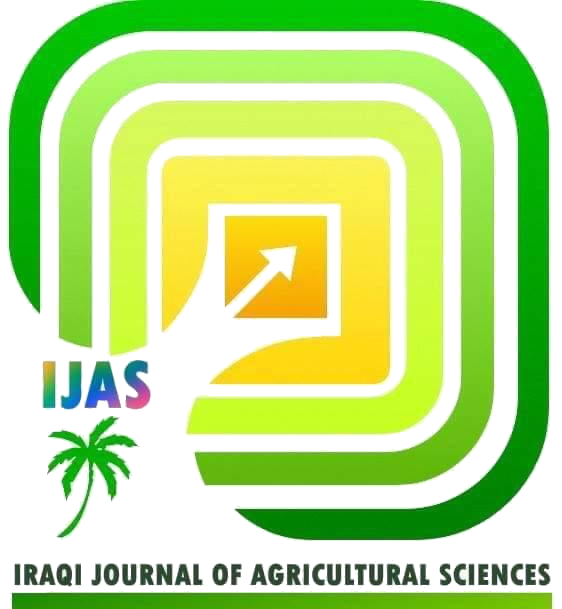ALLELOPATHIC EFFECT OF ROOT EXUDATES FROM SOME SUNFLOWER CULTIVARS ON ACCOMPANYING WEEDS
DOI:
https://doi.org/10.36103/kay68203Keywords:
phenolic compounds, Flammee cultivar, Sakha cultivar, secondary compounds.Abstract
The study looked at what happened to the weeds growth in the field when different types of sunflowers released root exudates grown in the summer of 2023. The goal was to determine if sunflower types' allelopathic potential affects weed growth and number. The results showed that after 30, 60, 90, and 120 days of cultivation, the Flamme cultivar did better than the Sakha, Aqmar, and Abba5 cultivars in reducing the number of weeds and their dry weight. The weed density dropped by 60%, 46%, 38%, and 35% compared to the control treatment, and the weeds' dry weight dropped by 61%, 66%, 62%, and 53% compared to the control treatment, in that order. The Sakha and Aqmar cultivars were next. The Abba5 cultivar recorded the lowest reduction in the number of weeds and their dry weights. We used the staircase experiment method to get rid of any competition when we tested the allelopathic potential of the fluids from the Flamme and Sakha cultivars. The Flamme cultivar's root exudates were found to be better at stopping the growth and dry weight of wild beet and purple panic weed than the Sakha cultivar's root exudates. The high-performance liquid chromatography test revealed that the Flamme and Sakha cultivars' root exudates had nine different compounds. The amounts of these phenolic compounds varied between the two studied cultivars. Most of the isolated compounds were found in higher amounts in the Flamme cultivar than in the Sakha cultivar. Most of the isolated compounds are known to stop plants, even weeds, from sprouting and growing naturally.
References
.Albehadili, A. A. J. 2019. Allelopathic effect of barley Cultivars residue on companion weeds growth of cowpea. Plant Archives,19(2), 424-429. https://plantarchives.org/SPL%20ISSUE%20SUPP%202,2019/75%20(424-429).pdf
2.Akter,P., A.M.Abu Ahmed.,F.K. Promie and M.D.E. Haque.2023. Root Exudates of Fifteen Common Weed Species: Phytochemical Screening and Allelopathic Effects on (T. aestivum L.) Agronomy, 13(2), 381;
https://doi.org/10.3390/agronomy13020381
3.AL-Behadili,A.A.J. 2024. Isolation and identification of allelopathic compounds from the residues of some sunflower cultivars using HPLC technology. Iraqi Journal of Agricultural Sciences,55(6), 1903-1909. https://doi.org/10.36103/g5wh8034
4.AL-Behadili1,A.A.J and L.Z.Fadhel.2023. Integration of sunflower and sorghum water extracts applied alone or in combination with reduced doses of chevalier for weed control in wheat. Iraqi Journal of Science,64(7), 3330-3339. . https://doi.org/10.24996/ijs.2023.64.7.14
5.Almarie, A. A. A. 2020. Roles of terpenoids in essential oils and its potential as natural weed killers: recent developments. Essential Oils-Bioactive Compounds, New Perspectives and Applications, pp.189-210.
https://www.intechopen.com/chapters/72424
6.Alsaadawi, I. S. and E. L. Rice. 1982. Allelopathic effects of Polygonum aviculare L. I. Vegetational patterning. Journal of Chemical Ecology 8: 933-1009. 10.1007/BF00987881
7.Alsaadawi, I. S., H. M. Malih., N.R. Lahmod and A. Khaliq.2024. Allelopathic potential of corn residues to manage weeds in cowpea. Allelopathy Journal ,63 (1): 31-44. https://doi.org/10.26651/allelo.j/2024-63-1-1497
8.Benavides-Mendoza, A., A. J. Maldonado and S. González-Morales. 2023.The Allelopathic Activity of Aqueous Extracts of (Helianthus annuus L.). Grown in Boreal Conditions, on Germination, Development, and Physiological Indices of( Pisum sativum L.). Plants,12(9):1920. doi: 10.3390/plants12091920
9. Bharat Malunjkar, B., R. Lokhande and S. Chitodkar. 2024. The Significance of Sunflower in Ecology and Agriculture. AgroScience Today,5(3):811-813.: https://www.researchgate.net/publication/379696637
10.Bouwmeester, H., R. C. Schuurink., P. M. Bleeker and F. Schiestl.2019. The role of volatiles in plant communication.The plant journal, 100, 892–907. https://doi.org/10.1111/tpj.14496
11. Chen,Q., B. Wang, D. Haiyan., Z. Jiang and L. Shengchun .2019. The role of NADP-malic enzyme in plants under stress. Plant Science.281, 206-212. https://doi.org/10.1016/j.plantsci.2019.01.010
12.Choudhary, C. S., B. Behera., M. B. Raza., K. Mrunalini., T. K.Bhoi.,M. K. Lal and T. K. Das. 2023. Mechanisms of allelopathic interactions for sustainable weed management. Rhizosphere, 25,pp. 100667. https://doi.org/10.1016/j.rhisph.2023.100667
13.Chui-Hua, K., L. Zheng., L. Feng-Li., X. Xin-Xin and P. Wang. 2024. Chemically Mediated Plant–Plant Interactions: Allelopathy and Allelobiosis.Plants.13(5):626
DOI: 10.3390/plants13050626
14. Dehghanian, Z., K. Habibi., M. Dehghanian., S. Aliyar., B. A. Lajayer., T. Astatkie and C. Keswani.2022. Reinforcing the bulwark: unravelling the efficient applications of plant phenolics and tannins against environmental stresses. Heliyon,8(3):1-12. https://doi.org/10.1016/j.heliyon.2022.e09094
15.García Romera,J.,R.Castanera.,.J.Casacuberta and C. Domingo.2024. Deciphering the Genetic Basis of Allelopathy in japonica Rice Cultivated in Temperate Regions Using a Genome Wide Association Study. Rice, 17,22.
https://doi.org/10.1186/s12284-024-00701-3
16.Gfeller,A.,G.Glauser.,C.M.Etter.,C.Signarbieux and J. Wirth.2018. Fagopyrum esculentum Alters Its Root Exudation after Amaranthus retroflexus Recognition and Suppresses Weed Growth. Original research article,9:1-13. https://doi.org/10.3389/fpls.2018.00050
17. Janusauskaite, D. 2023. The Allelopathic Activity of Aqueous Extracts of Helianthus annuus L., Grown in Boreal Conditions, on Germination, Development, and Physiological Indices of (Pisum sativum L.).Plants, 12(9):1920. doi: 10.3390/plants12091920
18. Javaid, M. M., A.Mahmood., M.I.Bhatti., H.Waheed., K.Attia.,A.Aziz and X.Wang. 2022. Efficacy of metribuzin doses on physiological, growth, and yield characteristics of wheat and its associated weeds. Frontiers in Plant Science, 13(4), 1-11. 10.3389/fpls.2022.866793
19. Jinxin, L.,C. Le.,Q.Chen., M.,P. Zheng and D. Hongzhi. 2021. Allelopathic effect of Artemisia argyi on the germination and growth of various weeds. Scientific Reports,11:4303.
doi: 10.1038/s41598-021-83752-6
20. Kong, C H., W. Liang., X. Xu.,F.Hu., P.Wang and Y.Jiang. 2004. Release and Activity of allelochemicals from allelopathic rice seedling. Agricultural and Food Chemistry. 52(10), 2861-2865. 10.1021/jf035467i
21.Kong, C. H., T. D. Xuan., T. D. Khanh., H.D.Tran and N.T. Trung. 2019. Allelochemicals and signaling chemicals in plants. Molecules, 24(15), 1- 19. 10.3390/molecules24152737
22.Kostina-Bednarz, M., J. Plonka and H. Barchanska. 2023. Allelopathy as a source of bioherbicides: challenges and prospects for sustainable agriculture.Reviews in Environmental Science and Bio/Technology, 22(2):1-34.
DOI: 10.1007/s11157-023-09656-1
23.Mahboobi, N and A. R. Heidarian. 2016. Allelopathic effects of medicinal plants on germination and seedling growth of some weeds. Journal of Fundamental and Applied Sciences, 8(2S), 323-336. http://dx.doi.org/10.4314/jfas.8vi2s.21
24. Maria, C. D., D. C. G. A. Pinto and A. M. S. Silva. 2021. Plant Flavonoids: Chemical Characteristics and Biological Activity. Molecules.26(17), 1-16. 10.3390/molecules26175377
25. Marija, R. A. M. Kulundžić., R. Baličević., M. Marković., M. V. Vuletić., D. Kranjac and A. Sarajlić. 2022. Allelopathic Potential of Sunflower Genotypes at Different Growth Stages on Lettuce. Applied Sciences,12(24) 12568; https://doi.org/10.3390/app122412568
26. Mushtaq, W., M. S .Badruzzaman and K. R. Hakeem.2020. Allelopathy Potential for Green Agriculture. SpringerBriefs in Agriculture (eBook),pp.1-76. https://doi.org/10.1007/978-3-030-40807-7
27.Ntombikhona ,A. K. ,A.A. Adedayo., O.O.Babalola and A. P. Kappo.2022. Microorganisms in Plant Growth and Development: Roles in Abiotic Stress Tolerance and Secondary Metabolites Secretion. Microorganisms, 10, 1528. https://doi.org/10.3390/microorganisms10081528
28. Pérez-Ochoa, M. L.,A. M. Vera-Guzmán., D. M. Mondragón-Chaparro and J. L. Chávez-Servia.2023. Effects of Annual Growth Conditions on Phenolic Compounds and Antioxidant Activity in the Roots of Eryngium montanum.Plants,12(18):3192. https://doi.org/10.3390/plants12183192
29.Pervin Aktera, P., A. Farhanaa and A. M. Abu Ahmedb.2022. Allelopathic response of root exudates of five common weeds in yard long bean (vigna unguiculata subsp L. sesquipedalis. and maize (zea maysL.). Acta Scientifica Malaysia, 6(1) : 01-05.
DOI: http://doi.org/10.26480/asm.01.2022.01.05
30. Quratul, A., M. Waseem .,W. M.Shadab and M. B. Siddiqui. 2023. Allelopathy: an alternative tool for sustainable agriculture. Physiology and Molecular Biology of Plants, 29(4):495–511.
doi: 10.1007/s12298-023-01305-9
31. Rawat, L. S., R. K. Maikhuri., Y. M. Bahuguna., N.K.Jha and P. C. Phondani.2017. Sunflower allelopathy for weed control in agriculture systems. Journal of Crop Science and Biotechnology,20:45-60. https://link.springer.com/article/10.1007/s12892-016-0093-0
32.Sarkar, B., A. Das., S. Pal., A. Kundu., M. Hasanuzzaman.,M.Fujita and M. K. Adak. 2023. Regulation of NADP-Malic Enzyme Activity in Maize under Salinity (Zea mays L.) with Reference to Light and Darkness.Plants, 12(9):1836. DOI: 10.3390/plants12091836
33.Sefaoglu1, F., H. Ozturk., E. Ozturk., M. Sezek., Z. Toktay and T. Polat. 2021. Effect of organic and inorganic fertilizers, or their combinations on yield and quality components of oil seed sunflower in a semi-arid environment. Turkish Journal of Fields Crops, 26(1), 88-95. https://dergipark.org.tr/tr/download/article-file/1537336
34.Sinan A. Abas, Z. A. Abdulhamed, and N. M. Abood. 2025. Impact of climate change on the growth, yield, and sunflower cultivar performance under the influence of plant density. Iraqi Journal of Agricultural Sciences, 56(Special), 10-19. https://doi.org/10.36103/9z5web62
35. Soares, M. M., C. D. M. Freitas., F.S.D.Oliveira., H.C.D.Mesquita., T.S.Silva and D.V. Silva. 2019. Effects of competition and water deficiency on sunflower and weed growth. Revista Caatinga, 32(2), 318-328. https://doi.org/10.1590/1983-21252019v32n204rc
36. Steel, R. G. D., J. H. Torrie and D. Dickey. 1997. Principles and Procedures of Statistics: A Biometrical Approach, 3rd Edn. McGraw Hill Book Co. Inc. New York, USA. pp. 172-177.
37. Tawfiq, A and I. S. Alsaadawi. 2014. Allelopathic Effect of Root Exudates of TwoSunflower Cultivars on Companion Weeds .Iraqi Journal of science,55 (4A), 1516-1509. https://ijs.uobaghdad.edu.iq/index.php/eijs/article/view/11247
38. Zahra Alizadeh, Z., R. R. Motafakkerazad., S. Y. Salehi-Lisar and G. Zarrini. 2023. Evaluation of the allelopathic effect of wheat and redroot pigweed on growth indices and antioxidant system activity in intercropping. Journal of Plant Protection Research,63(1), 97-112.
https://www.plantprotection.pl/pdf-159106-88478?filename=Evaluation%20of%20the.pdf
39.Zahraa K. K. Al- Salihi, and S. B. Salim. 2023. Effect of length and depth of the driptapeon wetting front advance in the root zone of sunflowr using hydrus 2d/3d program. Iraqi Journal of Agricultural Sciences, 54(3), 768-776.
https://doi.org/10.36103/ijas.v54i3.1759
40. Zixiang, S., Z.Shixing.,A. Shah.,Y. Arafat., S.A.H.Rizvi and H. Shao.2023. Plant Allelopathy in Response to Biotic and Abiotic Factors. Agronomy, 13(9),2358. https://doi.org/10.3390/agronomy13092358
Downloads
Published
Issue
Section
License
Copyright (c) 2025 IRAQI JOURNAL OF AGRICULTURAL SCIENCES

This work is licensed under a Creative Commons Attribution-NonCommercial-NoDerivatives 4.0 International License.

2.jpg)


